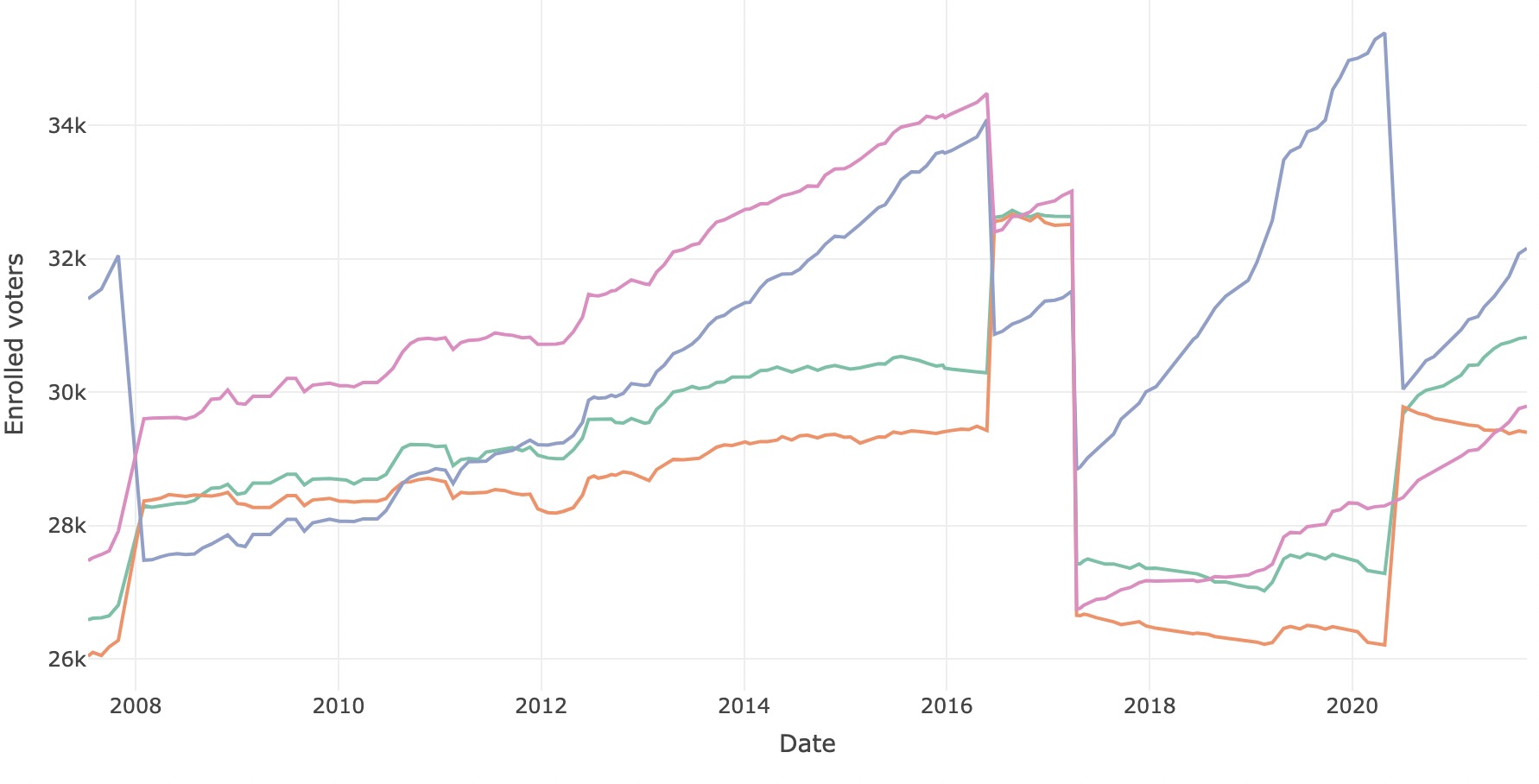Last week I put up a number of posts analysing enrolment data in the Greater Sydney region, with a focus on Camden and Blacktown. This is my last post on the topic, looking at a number of other councils.
While I made a number of charts and maps, the most useful one was the one showing the enrolment by ward for a particular council over time. It makes it easy to see the impact redistributions had on population trends, and how population growth has been distributed within a council.
In this post, I’ve picked six other large Sydney councils to see how they look with the same chart.
Firstly, let’s start with The Hills. This council has had the second-fastest growth since 2017, which is as far back as we can go in comparing the population in the Hills since the southern edge of the council was moved into the City of Parramatta. The fastest-growing part of the City of Blacktown is adjacent to The Hills.
The Hills has some of the same patterns as Camden and Blacktown – the high-growth North ward ended up well ahead of the other wards at the time of the 2008 and 2016 redistributions, but the redrawing did make it the least populous ward. In 2016, the North ward was redrawn to be a lot smaller than the other wards.
The amalgamation process forced a redrawing of wards again in 2017. Every ward shrunk, but the North was left as substantially bigger than its neighbours, and that gap widened over the next three years.
The most recent redistribution did narrow the gap, but the North ward has already outpaced the other wards. The East ward has not experienced any growth during the period covered by the chart, and has actually declined in enrolment since the last redistribution. So despite an attempt to equalise the wards, the population growth in three of the wards is moving in the opposite direction to the fourth ward.
Next up is Sutherland.
One of the largest councils in Sydney, a gap had started to widen between the A and D wards – 10.3% by the time of the 2016 redistribution. But you haven’t seen the same growth as in some of the western councils. The most populous A ward has stayed at the top of the list following that redistribution, but the second-most populous B ward moved to the bottom of the list, although it started to grow in 2018 and by 2021 it is almost as populous as the A ward. Still, they have kept all of the wards close together.
Next is Liverpool.
Liverpool has been steadily increasing, growing by 39% since 2007.
The council only has two wards, and the South ward has been consistently more populous than the North. I find it interesting that this has not triggered any redistributions between 2008 and 2020.
The 2020 redistribution did narrow the gap but still left the North ward about 8% larger than the South. The two wards are increasing at a similar rate, so we shouldn’t see a massive divergence unless population trends change.
Penrith has managed to avoid holding any redistributions since at least 2008, and possibly longer. A decade ago the North ward was consistently smaller than the other two, but only by about 5%.
Every ward has been growing at a decent clip, but the North started to accelerate in 2016, catching up to its neighbours in 2017 and zooming ahead. The South and East have barely grown over the last few years with most growth in the North, but even now the North is just 8% ahead. It seems likely a redistribution will be necessary before 2024.
I find Fairfield interesting. Growth has been practically non-existent over the last decade, with the three wards very similar in size. The largest ward was just 2.8% more populous than the smallest last year, when a redistribution completely redrew the council to be covered by just two wards.
The Fairfield/Cabravale ward is about 8% more populous than Parks ward, but there is no trend of them diverging (or growing at all) since the redistribution kicked in last year.
Finally, Inner West. This chart only covers the last four years since the amalgamations kicked in. No redistribution was held prior to the upcoming elections.
The wards are relatively close together, and if anything appear to have converged on each other.
But the most interesting thing is the downward trend. It’s one I’ve noticed in a few councils, and I’ll be returning to it in the next and final post in this series. While some councils in Sydney have continued to boom, others have seen a decline in electoral enrolment during the COVID-19 pandemic.



